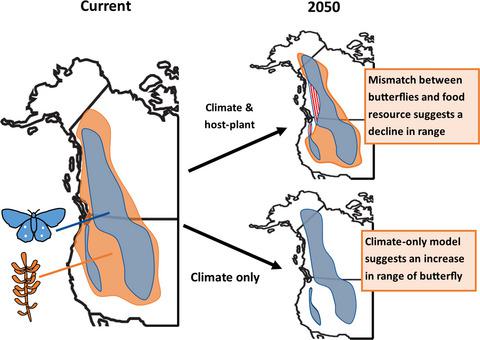当前位置:
X-MOL 学术
›
Glob. Change Biol.
›
论文详情
Our official English website, www.x-mol.net, welcomes your
feedback! (Note: you will need to create a separate account there.)
Inclusion of trophic interactions increases the vulnerability of an alpine butterfly species to climate change.
Global Change Biology ( IF 10.8 ) Pub Date : 2020-03-20 , DOI: 10.1111/gcb.15068 Alessandro Filazzola 1 , Stephen F Matter 1, 2 , Jens Roland 1
Global Change Biology ( IF 10.8 ) Pub Date : 2020-03-20 , DOI: 10.1111/gcb.15068 Alessandro Filazzola 1 , Stephen F Matter 1, 2 , Jens Roland 1
Affiliation

|
Climate change is expected to have significant and complex impacts on ecological communities. In addition to direct effects of climate on species, there can also be indirect effects through an intermediary species, such as in host–plant interactions. Indirect effects are expected to be more pronounced in alpine environments because these ecosystems are sensitive to temperature changes and there are limited areas for migration of both species (i.e. closed systems), and because of simpler trophic interactions. We tested the hypothesis that climate change will reduce the range of an alpine butterfly (Parnassius smintheus) because of indirect effects through its host plant (Sedum sp.). To test for direct and indirect effects, we used the simulations of climate change to assess the distribution of P. smintheus with and without Sedum sp. We also compared the projected ranges of P. smintheus to four other butterfly species that are found in the alpine, but that are generalists feeding on many plant genera. We found that P. smintheus gained distributional area in climate‐only models, but these gains were significantly reduced with the inclusion of Sedum sp. and in dry‐climate scenarios which resulted in a reduction in net area. When compared to the more generalist butterfly species, P. smintheus exhibited the largest loss in suitable habitat. Our findings support the importance of including indirect effects in modelling species distributions in response to climate change. We highlight the potentially large and still neglected impacts climate change can have on the trophic structure of communities, which can lead to significant losses of biodiversity. In the future, communities will continue to favour species that are generalists as climate change induces asynchronies in the migration of species.
中文翻译:

营养相互作用的加入增加了高山蝴蝶物种对气候变化的脆弱性。
预计气候变化将对生态社区产生重大而复杂的影响。除了气候对物种的直接影响外,还可以通过中间物种(例如在宿主与植物的相互作用中)产生间接影响。在高山环境中,间接影响预计会更加明显,因为这些生态系统对温度变化敏感,并且两个物种(即封闭系统)的迁徙区域有限,并且由于营养相互作用更简单。我们检验了以下假设:由于其寄主植物(Sedum)的间接影响,气候变化将缩小高山蝴蝶(Parnassius smintheus)的范围sp。)。为了测试直接和间接的影响,我们使用了气候变化的模拟方法来评估有或没有景天属植物时的S. smintheus分布。我们还比较了在草地上发现的S.smintheus与其他四个蝴蝶种类的范围,这些种类是以许多植物属为食的通才。我们发现P. smintheus在仅气候模式中获得了分布面积,但是随着Sedum sp。的加入,这些增益显着降低。在干旱气候下导致净面积减少。与更通俗的蝴蝶物种P. smintheus相比在合适的栖息地中损失最大。我们的发现支持在响应气候变化的物种分布建模中包括间接影响的重要性。我们着重指出气候变化对社区的营养结构可能产生的巨大而仍然被忽视的影响,这可能导致生物多样性的重大损失。将来,随着气候变化引起物种迁移的不同步,社区将继续偏爱通才物种。
更新日期:2020-04-22
中文翻译:

营养相互作用的加入增加了高山蝴蝶物种对气候变化的脆弱性。
预计气候变化将对生态社区产生重大而复杂的影响。除了气候对物种的直接影响外,还可以通过中间物种(例如在宿主与植物的相互作用中)产生间接影响。在高山环境中,间接影响预计会更加明显,因为这些生态系统对温度变化敏感,并且两个物种(即封闭系统)的迁徙区域有限,并且由于营养相互作用更简单。我们检验了以下假设:由于其寄主植物(Sedum)的间接影响,气候变化将缩小高山蝴蝶(Parnassius smintheus)的范围sp。)。为了测试直接和间接的影响,我们使用了气候变化的模拟方法来评估有或没有景天属植物时的S. smintheus分布。我们还比较了在草地上发现的S.smintheus与其他四个蝴蝶种类的范围,这些种类是以许多植物属为食的通才。我们发现P. smintheus在仅气候模式中获得了分布面积,但是随着Sedum sp。的加入,这些增益显着降低。在干旱气候下导致净面积减少。与更通俗的蝴蝶物种P. smintheus相比在合适的栖息地中损失最大。我们的发现支持在响应气候变化的物种分布建模中包括间接影响的重要性。我们着重指出气候变化对社区的营养结构可能产生的巨大而仍然被忽视的影响,这可能导致生物多样性的重大损失。将来,随着气候变化引起物种迁移的不同步,社区将继续偏爱通才物种。











































 京公网安备 11010802027423号
京公网安备 11010802027423号